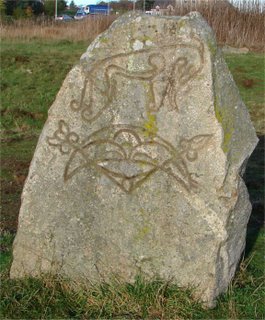 This one shows the figure known as the 'Pictish beast' because nobody knows what it's supposed to represent. Looking at other Pictish images, it's clear that these people were capable of representing what they saw. Horses, cattle, fish, eagles, are all instantly recognisable. So what's this thing?
This one shows the figure known as the 'Pictish beast' because nobody knows what it's supposed to represent. Looking at other Pictish images, it's clear that these people were capable of representing what they saw. Horses, cattle, fish, eagles, are all instantly recognisable. So what's this thing?
Some say it's meant to represent a dolphin. In that case, where's the dorsal fin? The picts must have come across dolphins at sea, and washed up on the beach. They knew what a dolphin looked like.
This image appears on many stones. It always looks the same. It represents something, but what? A mythical beast? Something the Picts hunted to extinction? Or maybe, just maybe, a species we haven't seen yet. Scotland is sparsely populated, with huge areas of wild land. The image gives no idea of scale: whether they carved eagle, horse or snake, they didn't carve them to correct relative sizes. The Pictish Beast might not be very big.
If it is mythical, it might represent a kelpie. Interesting, then, that they would include this image among their repertoire of mostly real animals. Could the kelpie be derived from a memory of a real creature? Again, not necessarily a large creature. Sizes tend to be flexible in folk tales.
So is this creature wandering around in Scotland somewhere? Most likely in rivers or lochs, since it looks to have fins rather than legs. It would be interesting to search for it (not least because fishing for wild trout is a particularly relaxing pastime) but it'll have to wait. Winter in the remote parts of Scotland is not something to be taken lightly. Best hold off until around May.
Even if it doesn't exist, spending a large part of next summer trout-fishing in Scotland, while legitimately claiming I'm working, is a very tempting prospect.
3 comments:
I couldn't begin to guess what that thing is (or a few of the others), but I'm fascinated that they drew a centaur. How old are these things?
I love to fish. One the last times I fished, I caught a 45 inch 25 pound Northern Pike, a 44 inch 24 pound Pike, and a 38 inch 19 pound Pike. I miss fishing and camping.
Are you almost ready to Beta?
The Picts are particularly fascinating because they appeared in around 400AD, but with no apparent prior history. Unlike the Angles, Saxons, Celts, whose arrival in Britain can be traced, there is no record of where the Picts came from. Even the name Pict comes from a Roman description of them. Nobody knows what name they called themselves. They were eventually absorbed into the Scots who finally took control of Scotland.
A quick summary can be found here: http://www.scottishweb.net/history/picts/scotland_the_picts.htm
Well, I guess I'd better take the beta plunge sooner rather than later... Does it hurt?
Only moderately.
Post a Comment